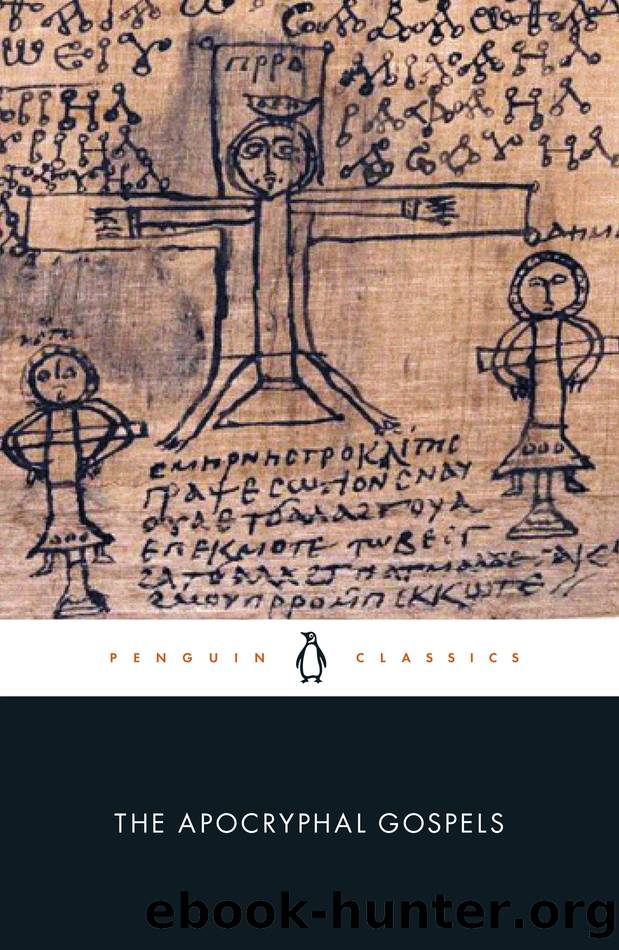The Apocryphal Gospels by Simon Gathercole

Author:Simon Gathercole [Gathercole, Simon]
Language: eng
Format: epub
ISBN: 9780241340561
Publisher: Penguin Books Ltd
Published: 2020-12-03T00:00:00+00:00
32 The Gospel of Nicodemus
(fifth century CE)
INTRODUCTION
The ancient Rabbis preserved a number of stories about a fabulously wealthy dynasty of men with the names Gurion and Nicodemus, whose family line can be traced back to the first century CE. This is the time-frame for the Gospel of Johnâs Nicodemus, who is the inspiration for the Gospel of Nicodemus here. According to the Gospel of John, he is a member of the Jewish ruling elite and extremely rich, as is evident from his provision of about 70 pounds of myrrh and aloes for Jesusâ tomb. The Rabbis mention similar wealth: it was said of one Nicodemus ben Gurion that he could provide wheat and barley for the whole population of Jerusalem for several years, and that his daughterâs perfume allowance was 400 gold coins a day.
The Gospel of Nicodemus belongs to the genre of âpseudo-archiveâ, and purports to be a Jewish record, composed by the Jewish councillor Nicodemus while Pontius Pilate was prefect of Judaea. A certain Ananias (who himself may be fictional) claims to have rediscovered it and translated it from Hebrew into Greek (see Prologue). The narrative begins with the Jews accusing Jesus to Pilate, and Pilate showing incredulity that they are condemning Jesus for healing on the Sabbath. Jesus is also accused of sorcery and blasphemy. This being Nicodemusâ account (ch. 5), he himself plays a significant role in Jesusâ defence, as do various beneficiaries of Jesusâ healing (chs. 6â8). Pilate vacillates, however, because the majority of Jews in this work oppose Jesus, while others maintain his innocence and goodness. Eventually Jesus is crucified, and the disciples go into hiding â all except for Nicodemus. When Joseph of Arimathaea appears (along with Nicodemus) in the Jewish assembly, he is promptly arrested and locked in a windowless room, with one guarded door; miraculously, however, he disappears (ch. 12). We learn later (ch. 15) that the risen Jesus raised the prison building off its foundations, enabling Joseph to walk out. Other Jewish authorities also claim to have seen the risen Jesus: Phinehas, Adas and Haggai witnessed some appearances of Jesus in Galilee (chs. 14â16). Some nice traditional legends are included in the Gospel of Nicodemus, such as the images of the emperor on Roman soldiersâ standards bowing down to Jesus. In another late legend, when Jesus goes to Egypt as a child, various Egyptian statues crash down before him.
Although the claim that the text comes from the Jewish archives is a fiction, it is possible that the author has some direct acquaintance with Judaism. The phraseology that âRabbi Levi said, testifying to the words from Rabbi Simeonâ sounds very like the Rabbinic language of one teacher transmitting a statement from another teacher (ch. 16). The Gospel of Nicodemus also notes at the beginning of the archival record that the proper name of the high priest, Caiaphas (a nickname), was actually Joseph. This is a detail which cannot be derived from the New Testament, but only from the historian Flavius Josephus or some other Jewish source.
Download
This site does not store any files on its server. We only index and link to content provided by other sites. Please contact the content providers to delete copyright contents if any and email us, we'll remove relevant links or contents immediately.
Kathy Andrews Collection by Kathy Andrews(11731)
The remains of the day by Kazuo Ishiguro(8827)
Paper Towns by Green John(5092)
Spare by Prince Harry The Duke of Sussex(5074)
Industrial Automation from Scratch: A hands-on guide to using sensors, actuators, PLCs, HMIs, and SCADA to automate industrial processes by Olushola Akande(4985)
The Body: A Guide for Occupants by Bill Bryson(4975)
Machine Learning at Scale with H2O by Gregory Keys | David Whiting(4186)
Be in a Treehouse by Pete Nelson(3951)
Never by Ken Follett(3795)
Harry Potter and the Goblet Of Fire by J.K. Rowling(3775)
Goodbye Paradise(3728)
Into Thin Air by Jon Krakauer(3313)
The Remains of the Day by Kazuo Ishiguro(3295)
The Cellar by Natasha Preston(3262)
The Genius of Japanese Carpentry by Azby Brown(3226)
Fairy Tale by Stephen King(3220)
120 Days of Sodom by Marquis de Sade(3184)
The Man Who Died Twice by Richard Osman(2997)
Drawing Shortcuts: Developing Quick Drawing Skills Using Today's Technology by Leggitt Jim(2996)
